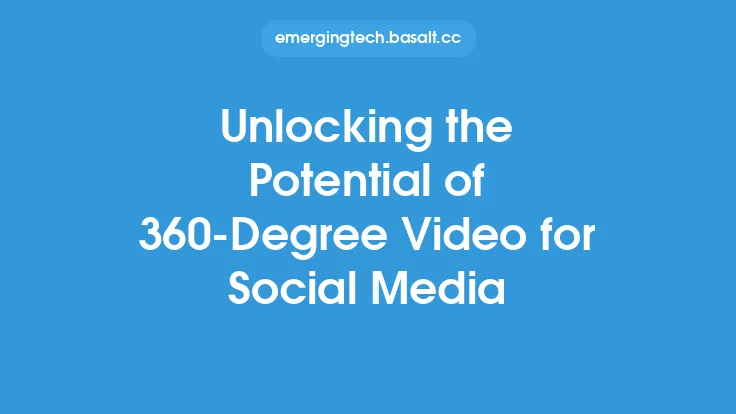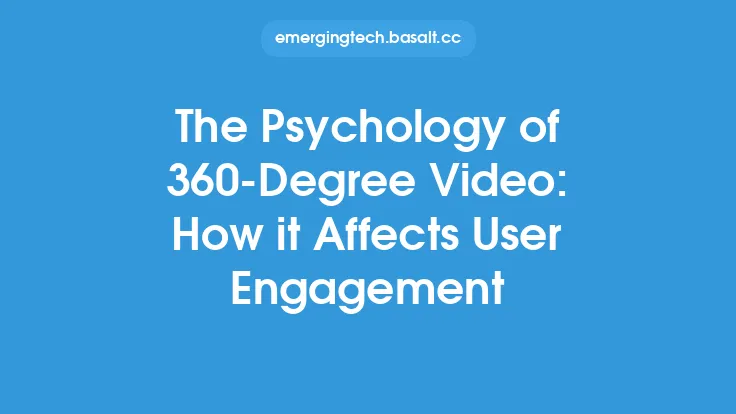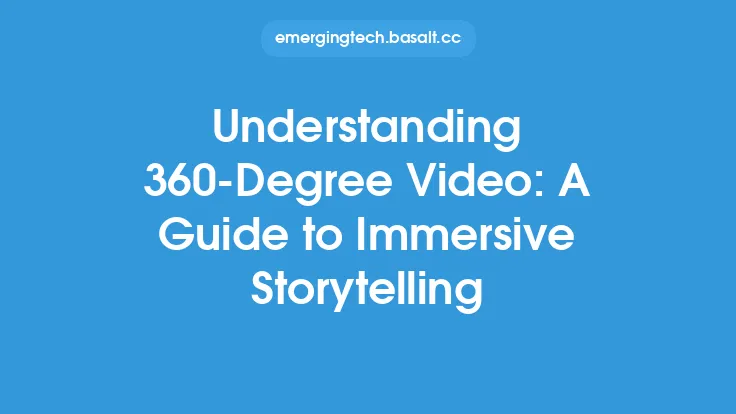The use of 360-degree video in education and training has been gaining popularity in recent years, and for good reason. This technology offers a unique and immersive way to learn, allowing students to engage with complex concepts and environments in a more interactive and memorable way. In this article, we'll explore the role of 360-degree video in education and training, including its benefits, applications, and technical considerations.
Introduction to 360-Degree Video in Education
360-degree video, also known as spherical video, is a type of video that captures a 360-degree view of a scene, allowing viewers to see everything around them. This is achieved using specialized cameras that capture multiple angles simultaneously, which are then stitched together to create a seamless and immersive experience. In education, 360-degree video can be used to create interactive and engaging lessons, simulations, and training programs. For example, medical students can use 360-degree video to practice surgeries, while engineering students can use it to explore complex systems and mechanisms.
Benefits of 360-Degree Video in Education
The benefits of using 360-degree video in education are numerous. Firstly, it provides an immersive and engaging experience, which can increase student motivation and participation. Secondly, it allows students to explore complex environments and systems in a safe and controlled way, reducing the risk of accidents and injuries. Thirdly, it provides a unique opportunity for students to practice and rehearse skills and procedures, which can improve their confidence and competence. Finally, 360-degree video can be used to create personalized and adaptive learning experiences, which can cater to the individual needs and abilities of each student.
Applications of 360-Degree Video in Education
360-degree video has a wide range of applications in education, including:
- Virtual field trips: allowing students to explore historical sites, museums, and other locations remotely
- Simulation-based training: providing students with a safe and controlled environment to practice skills and procedures
- Interactive lessons: creating engaging and immersive lessons that can increase student motivation and participation
- Virtual labs: allowing students to conduct experiments and investigations in a virtual environment
- Soft skills training: providing students with a safe and controlled environment to practice communication, teamwork, and leadership skills
Technical Considerations for 360-Degree Video in Education
To create and deliver 360-degree video content, educators need to consider several technical factors, including:
- Camera equipment: choosing the right camera and equipment to capture high-quality 360-degree video
- Video stitching: using software to stitch together multiple camera angles and create a seamless and immersive experience
- Video playback: choosing the right platform and software to play back 360-degree video content
- Head-mounted displays: using head-mounted displays (HMDs) or other devices to provide an immersive experience
- Audio: ensuring that the audio is high-quality and spatially accurate, to enhance the immersive experience
Best Practices for Creating 360-Degree Video Content for Education
To create effective 360-degree video content for education, educators should follow several best practices, including:
- Keep it simple: avoiding complex and cluttered environments, and focusing on simple and intuitive interfaces
- Use clear instructions: providing clear and concise instructions, to help students navigate the virtual environment
- Use interactive elements: incorporating interactive elements, such as hotspots and quizzes, to increase student engagement and participation
- Test and iterate: testing the content with students, and iterating on the design and delivery, to ensure that it meets their needs and expectations
Challenges and Limitations of 360-Degree Video in Education
While 360-degree video has the potential to revolutionize education, there are several challenges and limitations that need to be addressed, including:
- Cost: the cost of creating and delivering 360-degree video content, which can be prohibitively expensive for some educators and institutions
- Accessibility: ensuring that 360-degree video content is accessible to all students, regardless of their abilities or disabilities
- Technical issues: addressing technical issues, such as video playback and audio problems, which can disrupt the learning experience
- Pedagogy: ensuring that 360-degree video content is aligned with pedagogical principles and learning objectives, to ensure that it is effective and engaging.
Future Directions for 360-Degree Video in Education
The future of 360-degree video in education is exciting and rapidly evolving. As the technology continues to improve and become more affordable, we can expect to see more widespread adoption and innovative applications. Some potential future directions include:
- Integration with other technologies, such as augmented reality (AR) and virtual reality (VR)
- Use of artificial intelligence (AI) and machine learning (ML) to create personalized and adaptive learning experiences
- Development of new platforms and tools, to support the creation and delivery of 360-degree video content
- Increased focus on accessibility and inclusivity, to ensure that 360-degree video content is available to all students, regardless of their abilities or disabilities.





